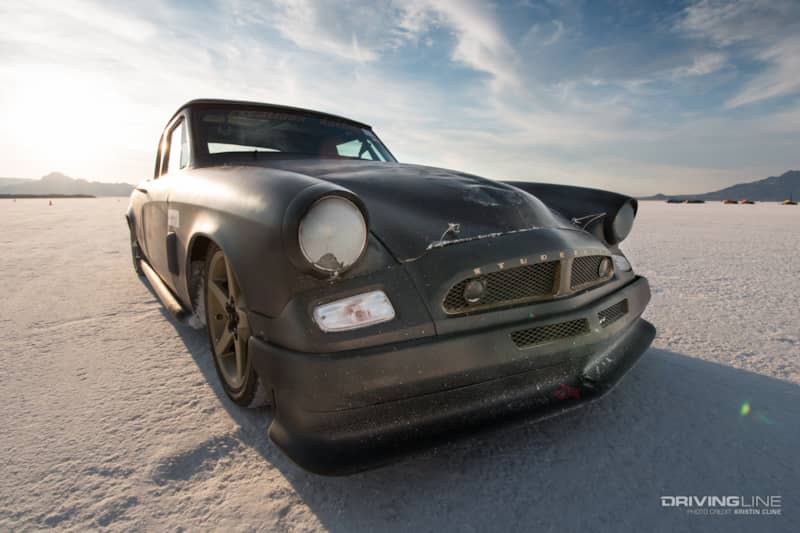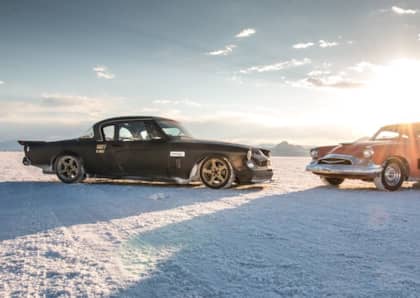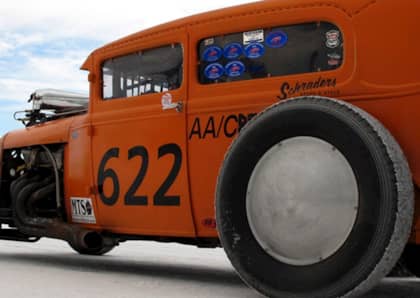Speed Seeking: Licensed to Race at Bonneville [Part 2]
Continued from Part 1, after fixing the blown-up hood from our first run at Speedweek. Click here for the first part of the Bonneville Salt Flats racing story.

Finally Time to Make Our First Run
Attending Speedweek as media, I’m used to constantly moving — running between courses, searching for cars and interviewing teams in the pits. Being there as part of a race team was a big change of pace. The only thing to do in line was wait. Fellow Studebaker enthusiasts, friends and spectators would stop by for a few minutes to chat. People were coming to find me for a change, and the hours passed by quickly.

In between passersby, Jerry, Ethan and I talked about our lives and the cars that have helped to shape them. Spending such an expansive amount of time with someone who days before had been a stranger seemed surprisingly normal. Jerry was quickly becoming a life-long friend. His generosity continued to strike me as unique, surprising and refreshing.

Within a couple hours we were at the start line once more. Again, Jerry would take this shakedown run and ensure everything was OK. Wait, take-off, hurry behind. We found him and the Studebaker at the end of the course, smiling soundly and laughing. We’d done it. We were here, and we were running the car!
One more line, and some peanut butter and jelly sandwiches later, and it was me in the racing suit. It’s called “land speed racing,” but that doesn’t mean they let just any nut job out there to try and go as fast as possible. During a rookie run, you’re supposed to prove you know the proper steps to race on the salt. You need to go above 125 mph but no more than 150. Recorded time, on the rookie course, is taken as an average of your entire second mile — meaning you have 1 mile to get to speed, 1 mile to floor it and 1 mile to slow down.
A Rookie's First Race Down the Salt
Not sure if it was sitting in full racing gear in the middle of a desert in the middle of August or if it was merely my excitement to make my first run down the course, but it felt like I was sitting there forever. You’re expected to get dressed and buckled up a couple cars down the line. If any issues that delay running happen between buckling up and leaving the line, you just stay put and do what you can to stay cool. I didn’t mind the opportunity to calm my nerves and get used to the fact that I was finally in the driver’s seat. Having Jerry, my husband, dad, brother and uncle milling around and holding an umbrella to shade me was like having a little cocoon of care swarming around the car. I was thankful they were there to help and share in this. I felt like the luckiest girl in the world.

At last, the Studebaker was rolled up to the line. Nothing stood between me and the vast expanse of salt. This was real. This was happening. The course starter asked me a couple of questions and checked my belts. The car was started and put in gear and the doors were closed.

It was just me and the car now. The healthy rumble of the engine seemed muffled in my state of focus as I put my helmet’s visor down and got the hand signal from the starter to pull off the line. I was at once intensely aware of everything going on around me — the engine’s song and car noises, the chase truck disappearing behind and the orange cones blipping by on the periphery.

As the speed increased, the noises died down. It was eerily quiet. I was at once fully at peace and fully alive. This was not playing it safe or sitting by the sidelines. This was not a wallflower moment. This was life demanding that you show up in a big way. That, just like the car, you must operate in high performance. I surveyed the space around me, the landscape offering little to no marker of my speed. Mechanical speedometers don’t work at these speeds, rather RPMs are used to calculate an approximate mph. Exiting the second mile, the timed portion, I kept tabs on the RPM to ensure I would hit my target speed for my rookie license. I couldn’t help but let out a little victory yell as I slowly lifted my foot off the throttle.
We’d been instructed to pull off as soon as we felt it safe to do so, not necessarily to use the entire third mile to slow down. But I didn’t want to cut my run short, plus I was afraid my speed perspective was slightly warped and didn’t want to turn before it was safe to do so. So, I stayed on course until the graded white salt began to get bumpy with patches of dirt showing through and flags marked the end of course. Shutting the engines off, I rolled to a stop on the return road.

Going through my bailout steps, I exited the car and got my helmet off. I had a couple moments of silence to take in the middle-of-nowhere quiet before Jerry and Ethan arrived in the chase truck, I was still buzzing with life. It was one of those rare moments when the ordinary becomes the extraordinary; those moments don’t last long, but when they show up you drink them in.

Licensing at Speedweek
It was Sunday, and our goal was to get in as many runs as possible before the end of the day. As we posted the car in line again, I left to pick up my timing slip. My time: 128.679 mph. Just enough to get signed off as a rookie and gain my Class “B” racing license! Two hours later, and I was running once more, no less exciting than the first — this time, getting up to 149.52. If I could break 150, I’d get my next class license. SCTA driver’s licenses step up gradually through classes D to AA before earning an “Unlimited” 300 mph or faster license.

By the end of the day Jerry, Ethan and I were returning from runs and switching our shared racing gear as quickly as possible to get the next driver ready to take the next run. We must have been a sight, stripping off the shared racing shoes and suit with only our fireproof Long Johns underneath; at the end I didn’t even bother putting on any real pants before jumping in the truck!

We netted at Jerry and myself both getting three runs and Ethan getting two. Jerry got the car fastest, 151.926 mph, while I was right behind him with a 150.710 — meaning, I qualified for my Class “C” license. Nobody wanted the day to end, but we couldn’t have asked for a more successful day of racing. For us, we weren’t attempting to break records, we were just out there to have fun — whetting our appetites for bigger ventures.

They call it “salt fever,” the fervor to go just a little bit faster and return to the salt each year. I hadn’t even pulled off the track of my rookie run before a strong inner drive was telling me, “I want to go faster.” My guess is this drive will take me on unexpected adventures as I build my own car with sights set on gaining entrance to the 200 mph club.

Picking up our official licenses the following day in the impound area, I ran into an old friend. After six years, his Flathead-powered Studebaker had just made a record-breaking pass. Glancing around at the smiles of the crew surrounding the car, I knew it wasn’t about the record; it was about the adventure in getting there. Looking down at the SCTA racing license in hand, I knew it wasn’t the finish line, but just the beginning of something even more magical.












